The Prevent duty of care and the wellbeing of staff and students in higher education (HE): notes for trainers
Published 22 June 2021
These notes support the points in the The Prevent duty of care and the wellbeing of students and staff in higher education (HE): PowerPoint slides.
Introduction
When delivering the training, you may wish to add in references to provider documents or processes to give additional clarity and guidance to your trainees.
Top tips for delivering this training
- Apply the same principles you would to all training activities – know your audience, identify their training needs, plan your approach carefully, develop a communication plan so that staff understand the purpose of the training, and why they should engage with it.
- Be open and transparent – recognise that staff will have preconceptions and concerns about Prevent, draw these out and address them at the start of face-to-face sessions. This can work well as an icebreaker.
- Involve staff and students in discussions about training, working in partnership with staff and student representatives. Use both existing mechanisms (committees, staff-student liaison groups, departmental meetings, etc) and any Prevent-specific mechanisms in place.
- Think how you can use the expertise of other specialists in Prevent training – data protection and FOI officers. For example. bringing in equality and diversity officers can help staff understand how Prevent interacts with equality and diversity legislation.
Outline
The presentation will consider what the Prevent statutory guidance says about the Duty and its implications for the RHEB to provide pastoral support to students. It will also consider when providers might owe a duty of care – to students and staff and visitors – and whether the Prevent Duty has changed the position significantly.
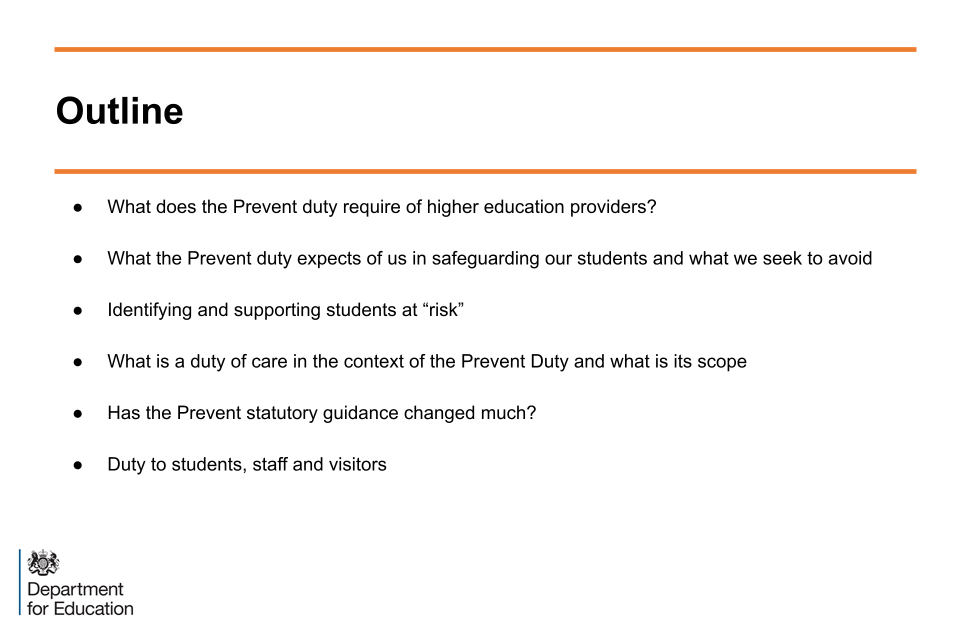
An image of slide 1: outline
What the Duty says
This explains to the audience the specific nature of requirements of the Prevent Statutory Duty that is placed upon providers in the Counter-Terrorism and Security Act (2015) (as amended). There is specific statutory guidance regarding the Duty for higher education and that came into force on 18 September 2015.
The Duty in Section 26 of the Act is that authorities must “have due regard to the need to prevent people from being drawn into terrorism”.
References to RHEBs in the slide refers to relevant higher education bodies. These fall within the definition of “specified authorities” in schedule 6 Counter-Terrorism and Security Act (2015) (as amended) and therefore the Duty applies.
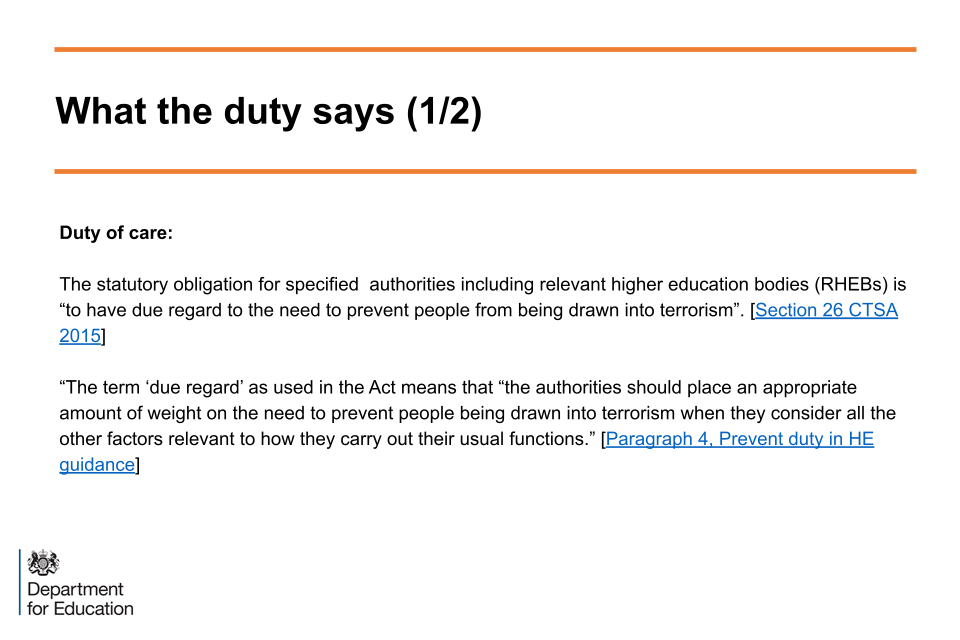
An image of slide 2: what the duty says, slide 1 of 2
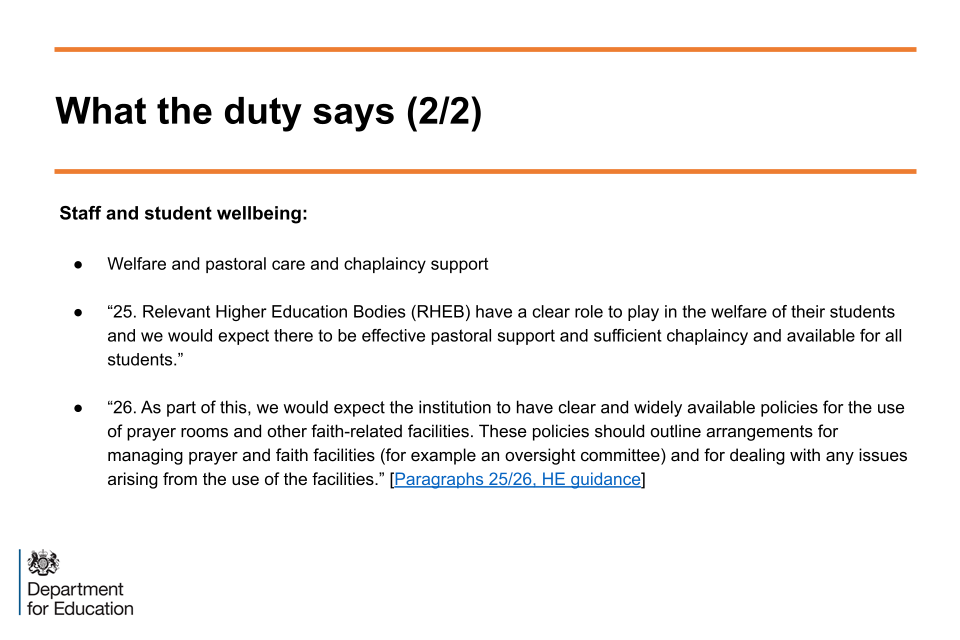
An image of slide 3: what the duty says, slide 2 of 2
Students at risk
This slide asks the audience to consider the variety of ways in which students may become at risk during their journey in higher education and how they might be supported.
Discussion on the broader risks to students may provide a useful starting point to identify vulnerabilities, often a key aspect that is exploited when individuals are drawn into supporting terrorist and extremist causes.

An image of slide 4: students at risk
Providing clarity
This is a useful point to offer the audience some reassurance of what is not required of them and to highlight examples of incidents which we would seek to avoid.
The headlines used are genuine but in each case they reflect staff and other agencies not following prescribed reporting/welfare referral pathways or inadequate staff Prevent training.
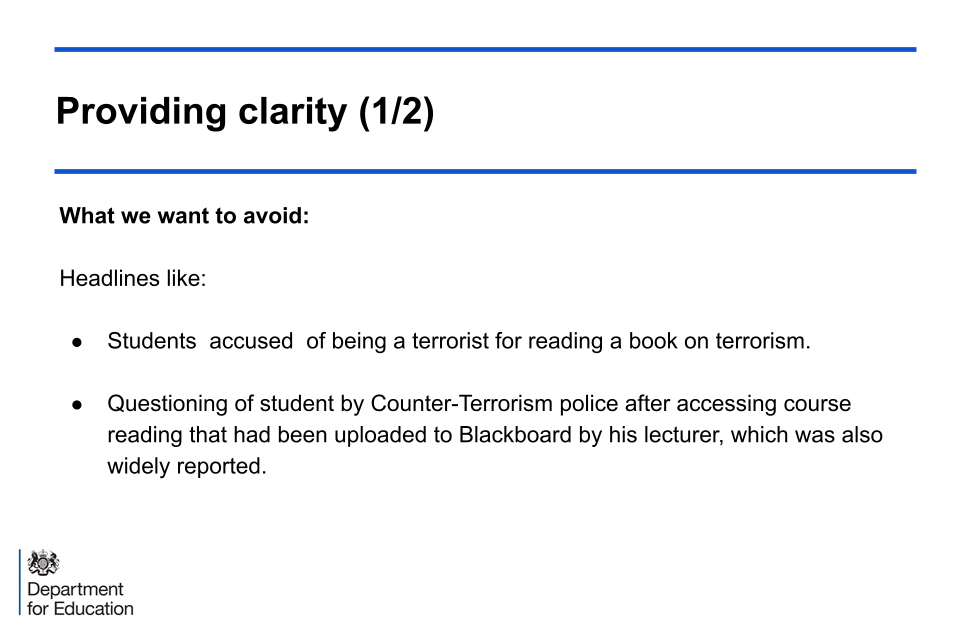
An image of slide 5: providing clarity, slide 1 of 2
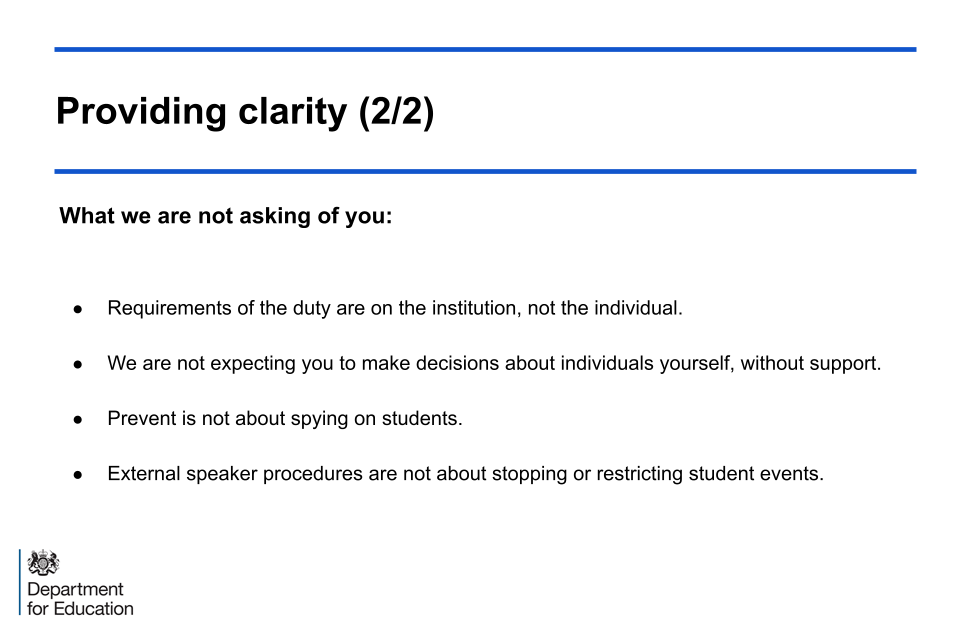
An image of slide 6: providing clarity, slide 2 of 2
Key considerations
These are some important considerations to be remembered when implementing the Duty.
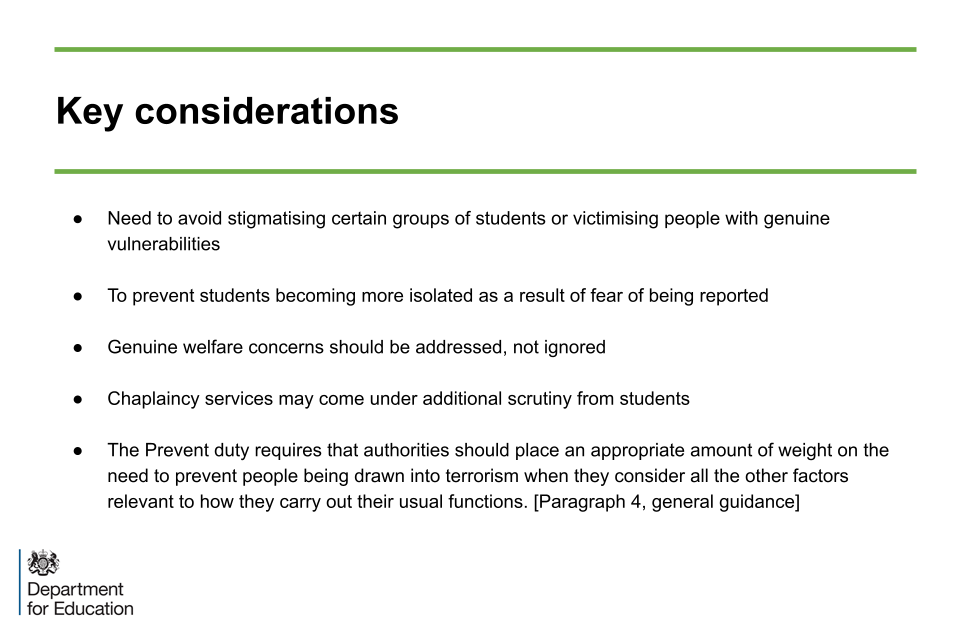
An image of slide 7: key considerations
Achieving compliance
These slides highlight quotes from the statutory guidance which demonstrate some specific requirements and areas that should be considered by RHEBs for them to be compliant with the Duty. The slides also clarify that compliance in this respect is judged by the Office for Students (OfS).
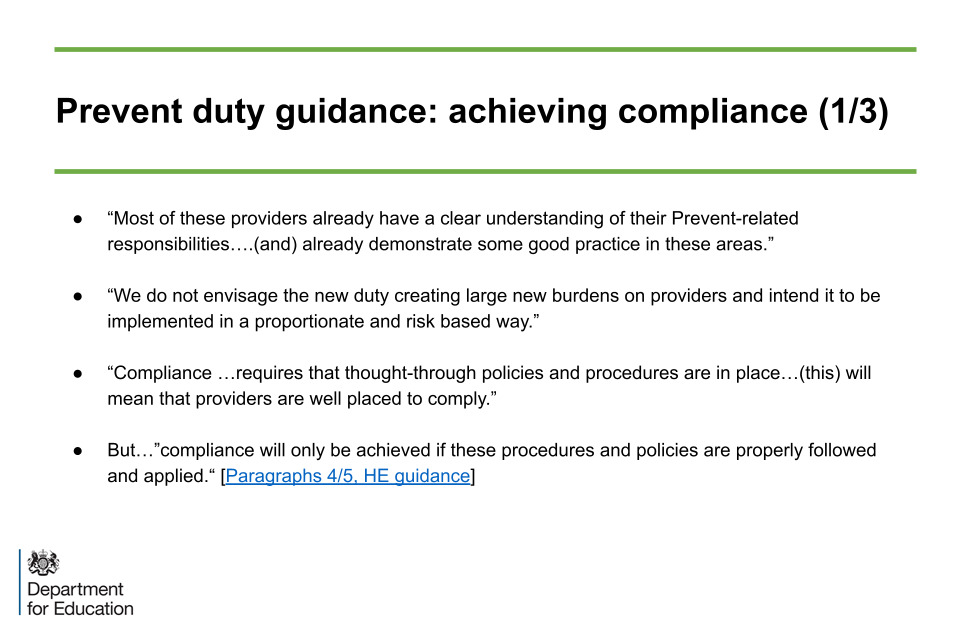
An image of slide 8: Prevent duty guidance, slide 1 of 3

An image of slide 9: Prevent duty guidance, slide 2 of 3
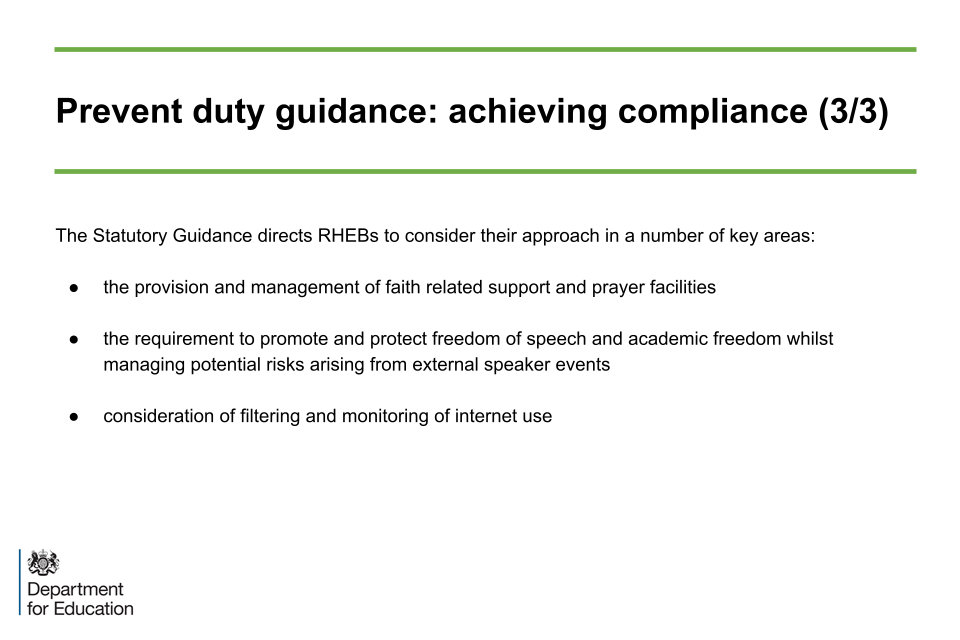
An image of slide 10: Prevent duty guidance, slide 3 of 3
What is a provider’s duty of care?
These slides introduce the discussion that forms the remainder of the presentation – the extent to which and in what circumstances institution’s owe a legal duty of care to students, staff and visitors – and how the Prevent Duty interacts with any duties that exist.

An image of slide 11: What is a providers duty of care
When can a duty of care arise?
Firstly, where there is a contract in place and where in the student contract the RHEB promises levels of support, reasonable adjustments, counselling provision, etc, a duty of care arises. If the university fails to provide that level of care, which can then be shown to lead to injury, it may face claims in negligence.
The Prevent statutory guidance is less explicit with regards to an institution’s duty of care. Provided they pay due regard to the Duty as set out in the guidance and can demonstrate that they have placed appropriate weight upon the Duty in carrying out its normal functions, they should be considered to have exercised the appropriate level of duty of care.
The courts look for foreseeability, or put another way, ‘is it fair and reasonable to expect the higher education provider to safeguard a person’s interests rather than expect that person to keep him or herself free from harm?’ In respect of those students (or staff) we know to have certain vulnerabilities (e.g. mental health issues or physical disabilities), we are likely to be able to foresee injury more clearly, in respect of those vulnerabilities.
We therefore need to act reasonably to prevent such injury occurring. It is feasible that failing to intervene to support a student who shows signs that they are being radicalised may make the university susceptible to a claim that they have been negligent, but it is very unlikely that in practice such a claim would arise.
However, even this remote possibility reinforces the requirement for policies on student welfare and arrangements for supporting students who are a cause for concern to incorporate reference to the Prevent Duty, and that staff are aware of the procedures and trained to know what to do where someone appears to be vulnerable to being drawn into terrorism.
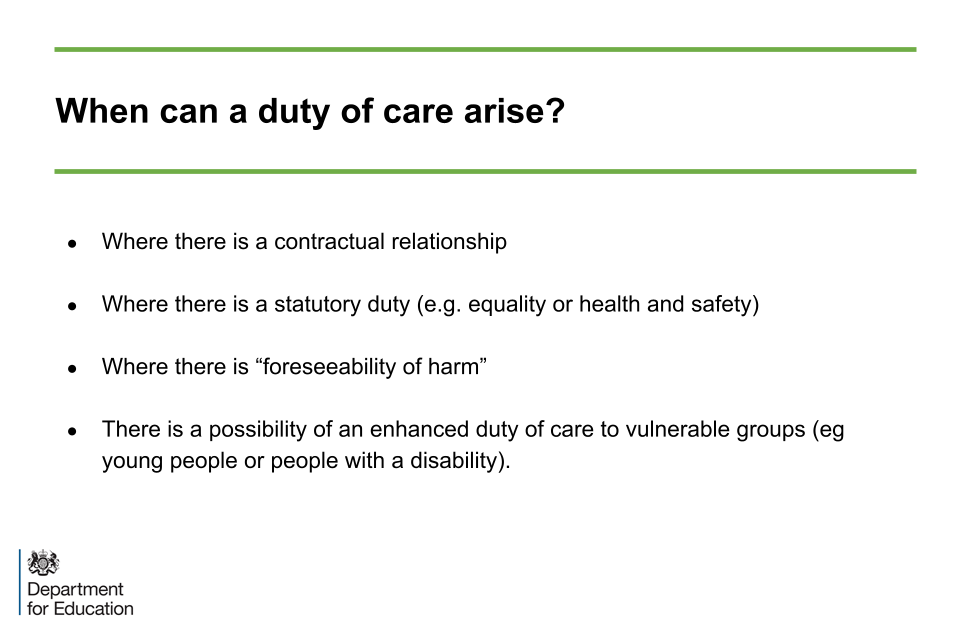
An image of slide 12: when can a duty of care arise
What level of duty?
This is important. A duty of care does not mean that a provider has to guard against every conceivable harm that might arise. It does mean that a provider has to think about and risk assess its activities. It then needs to take action which is reasonable in the circumstances. This resonates with the requirement for risk assessment and action planning in implementing the Prevent Duty.
The provider must ensure staff providing care and support understand the Prevent Duty and can recognise vulnerability to radicalisation – training is important, as is the need for staff to recognise their limitations. The latter is important in the context of Prevent and in particular, referrals to Channel – expertise should rest with a small number of staff. The majority of staff need to understand the procedures for raising concerns internally and the support available. This applies when there are concerns that someone is being drawn into terrorism or extremism, as it should apply in other circumstances – for example students whose mental health has become a cause for concern.
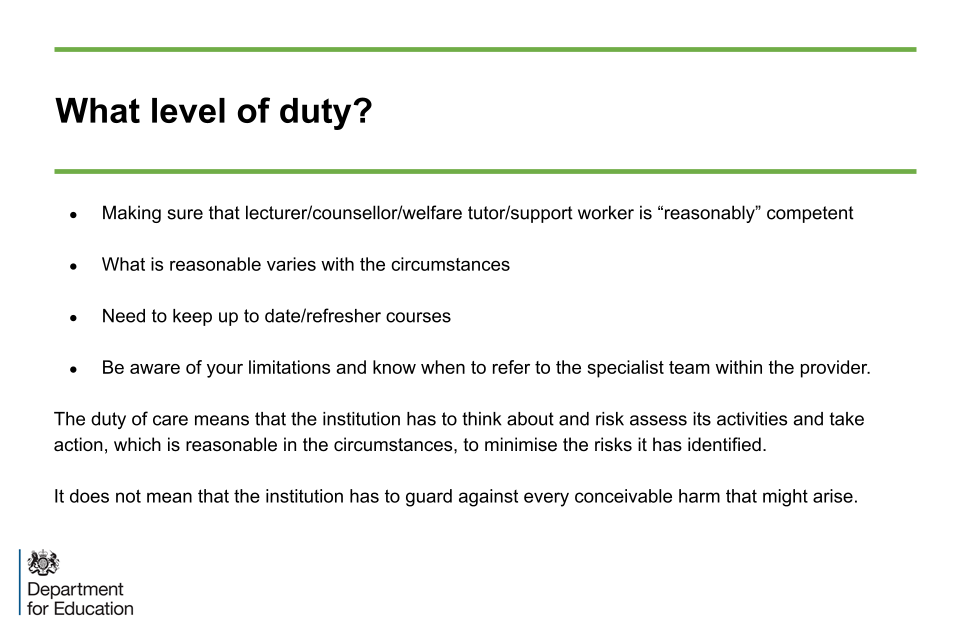
An image of slide 13: what level of duty
Duty 1 - freedom of speech and external speakers
This slide sets out the duty to students in ensuring freedom of speech and academic freedom. This is not new - for most providers it has existed for a considerable time (this was already a requirement resulting from the Education (No.2) Act (1986) and Education Reform Act (1988)).
The introduction of the Prevent statutory duty has reinforced the need to have in place and apply policies in this area. However, providers are now subject to monitoring by the OfS to ensure that they are compliant (Schedule 11, Section 35 Higher Education and Research Act 2017), which was not previously the case.
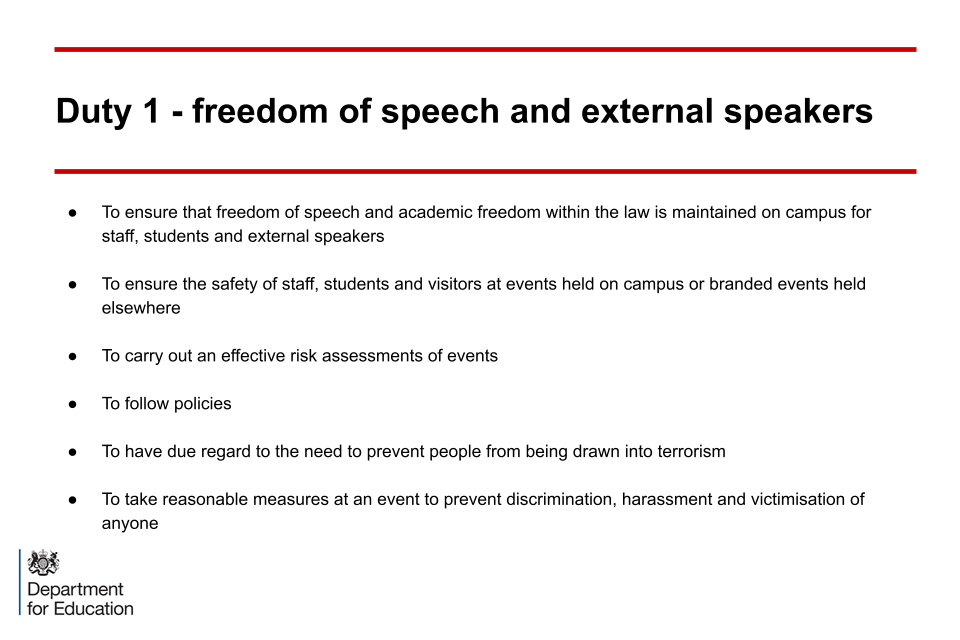
An image of slide 14: duty 1 - freedom of speech and external speakers
Duty 2 - towards staff
The Prevent Duty guidance requires that providers will have in place properly thought through policies and procedures, which in their formulation will have considered the reasonably foreseeable risks, and put in place mitigations to reduce these. Issues may arise where policies are not embedded within the organisation, and so the procedure is not followed.
This increases the possibility that injury or loss may occur (which had been mitigated within the policy), such as discrimination, breach of the Data Protection Act or failure to properly balance the competing duties placed on RHEBs.
Appropriate training and support is essential for all those who may be engaged with implementing the Prevent Duty at all levels. This should include staff with a responsibility to provide pastoral care to students, especially to those who may be vulnerable.
It is important that providers review their training programmes and ensure that they understand the Prevent Duty. Providers should be able to show that relevant staff are trained to recognise and know what to do where they are concerned that someone may potentially be open to being drawn into terrorism. There is an expectation that staff are competent to deal with these issues and robust procedures are in place to help them.
Providers will need to carefully consider the scope of their Prevent training programmes and bear in mind that any training is appropriate, role-specific and updated as required.
In light of the difficulties in balancing the competing duties, and the complex nature of any decision, for example to refer an individual to the Channel programme for support, it is essential that the policy requires staff to consult with specified role holders within the RHEB. It is good practice that decision-makers on referral to Channel should comprise a small defined group of no more than two or three people. They can bring to the discussion various expertise (such as an input from student services, an academic perspective, and possibly a legal perspective).
What is Channel?
Channel is a multi-agency scheme that local authorities are legally obliged to oversee and considers individuals referred for support in cases of potential radicalisation and where appropriate, provides a bespoke plan of support for them. Consent from the individual must be sought by the Channel panel for supportive interventions.
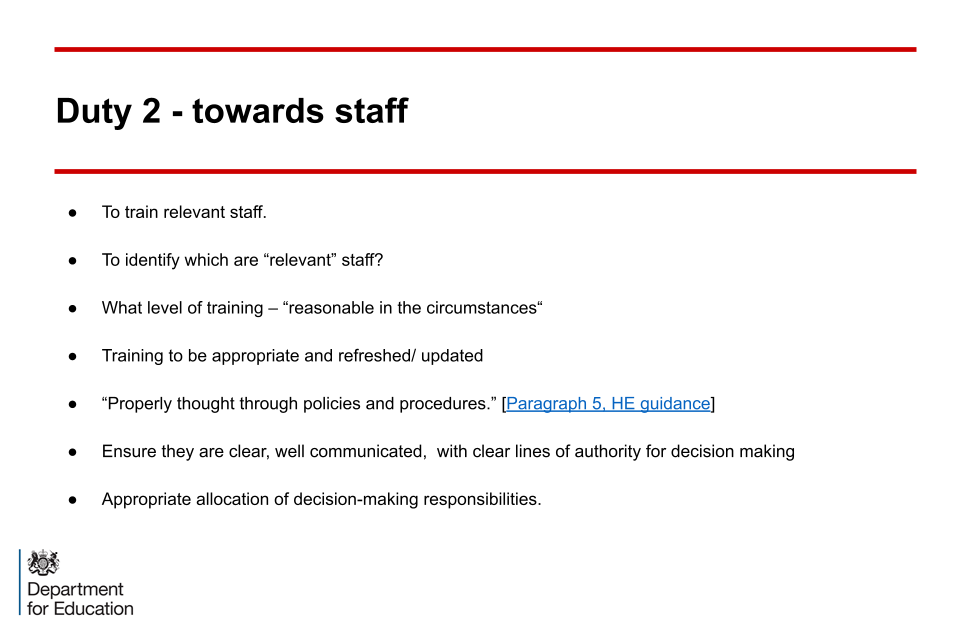
An image of slide 15: duty 2 - towards staff
Duty 3 – student support
There is an expectation that welfare and chaplaincy support is available to all students but the guidance is not prescriptive about how this should be achieved. Again, it is for the individual institution to decide based on local circumstances – including student profile. What is important is that any commitments in the student contract are deliverable and that relevant staff have the necessary training and support.
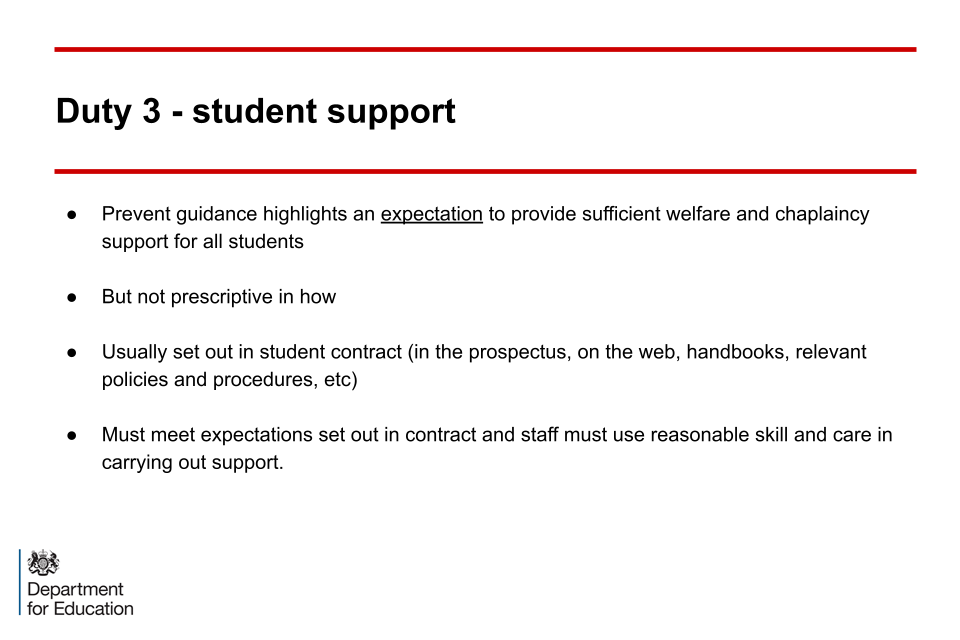
An image of slide 16: duty 3 - student support
Duty 4 – to students under GDPR
The need for compliance with General Data Protection Regulations (GDPR) is referenced in the Prevent statutory guidance – RHEBs must ensure that their arrangements to implement Prevent are consistent with their procedures for compliance with data protection legislation.

An image of slide 17: duty 4 - to students under GDPR
Duty 5 – equality law
All specified authorities must be mindful in implementing the Prevent Duty of their existing duties to comply with equality legislation and in particular the Equality Act (2010) (as amended) – for publicly funded providers this includes the public duty to promote equality – for private providers the other requirements relating to non-discrimination, harassment, victimisation etc.
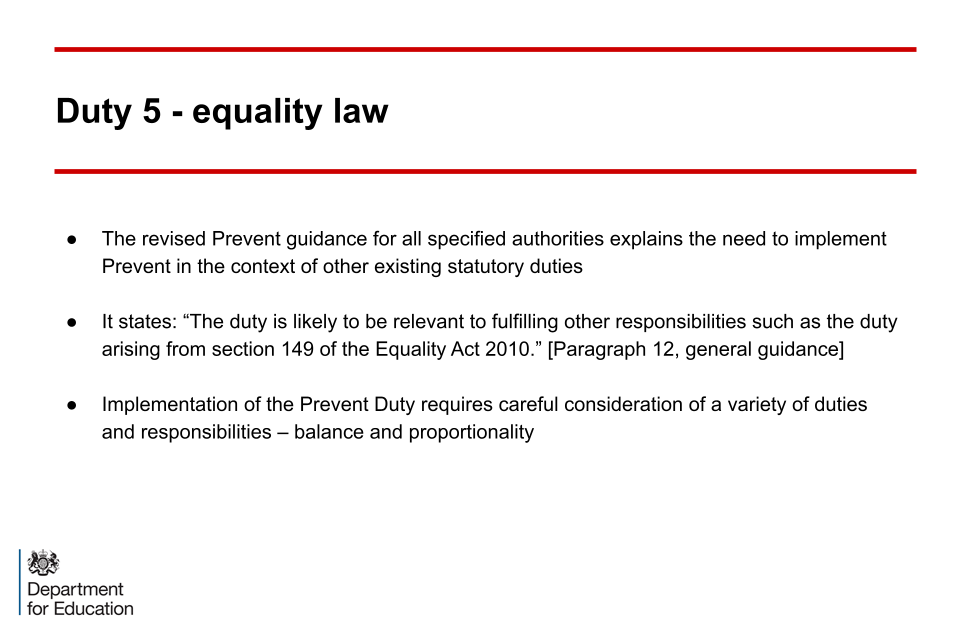
An image of slide 18: duty 5 - equality law
When does a breach of duty arise?
This slide summarises the circumstances where a breach of duty may arise.
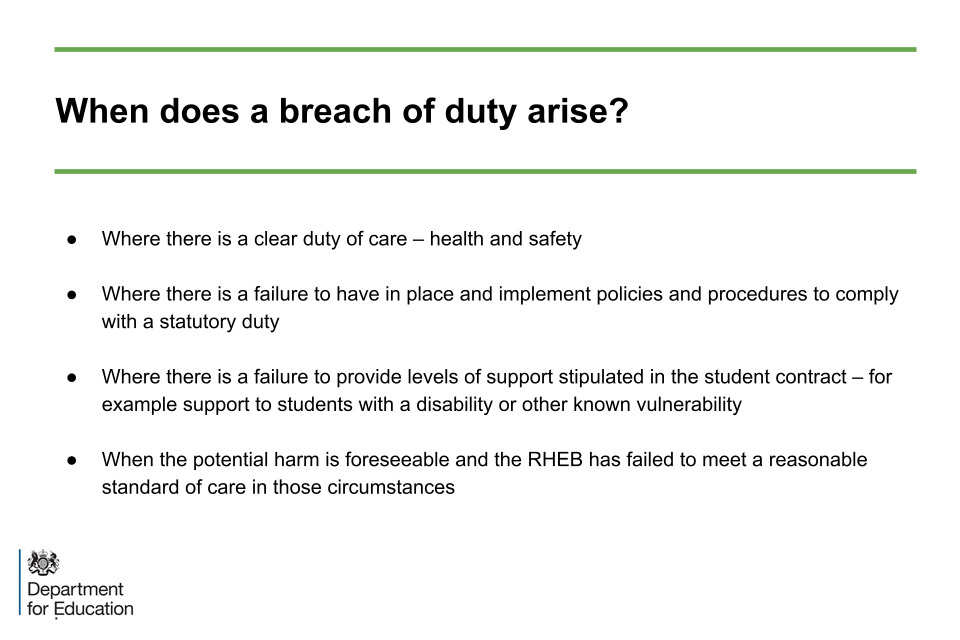
An image of slide 19: when does a breach of duty arise
Risk of litigation
The slide acknowledges that there is a theoretical risk of litigation should someone be drawn into terrorism because of something that is claimed to have happened on campus. But the risk is low – however, the risk would be greater if it were shown that the institution had failed significantly to implement the Duty.
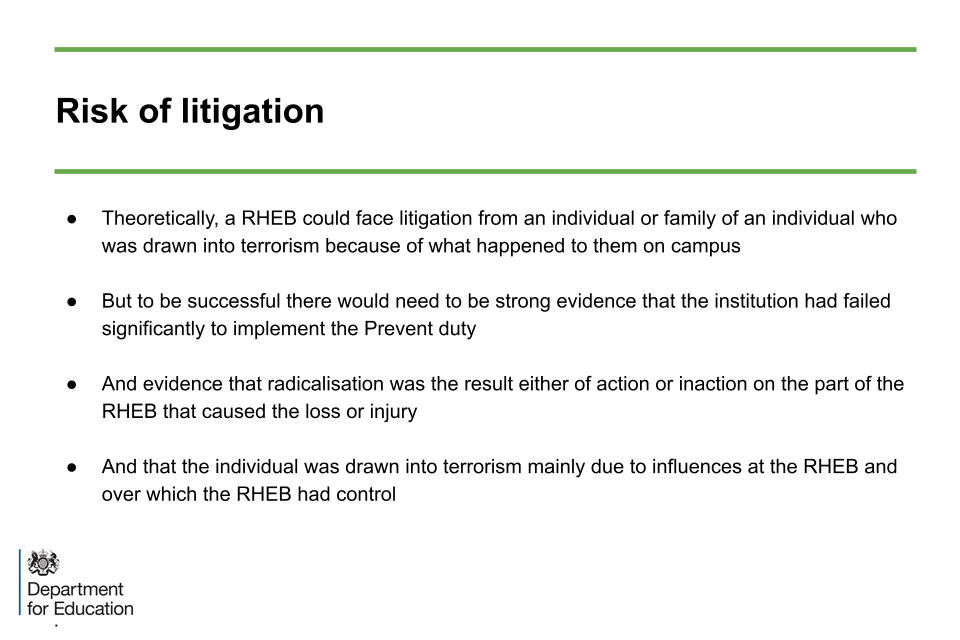
An image of slide 20: risk of litigation
In summary – student support
This slide summarises that staff and students should use existing channels to raise welfare (including Prevent) concerns and that an institution’s response should be proportionate.
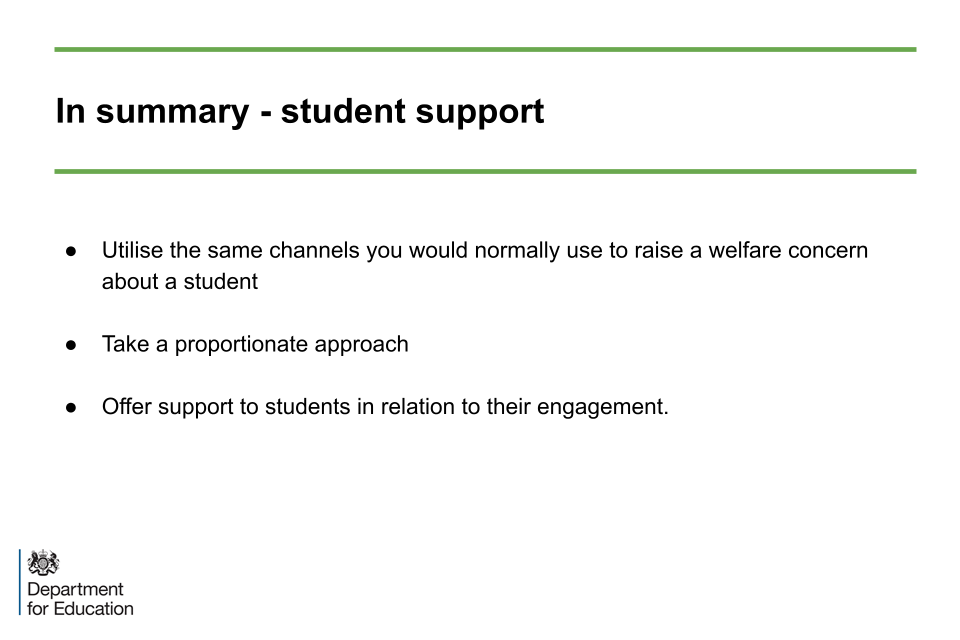
An image of slide 21: In summary - student support
In summary – duty of care
This slide summarises that there is a duty of care in certain circumstances to students, staff and visitors. This pre-dates the Prevent Duty and its introduction does not greatly increase the duty of care owed.
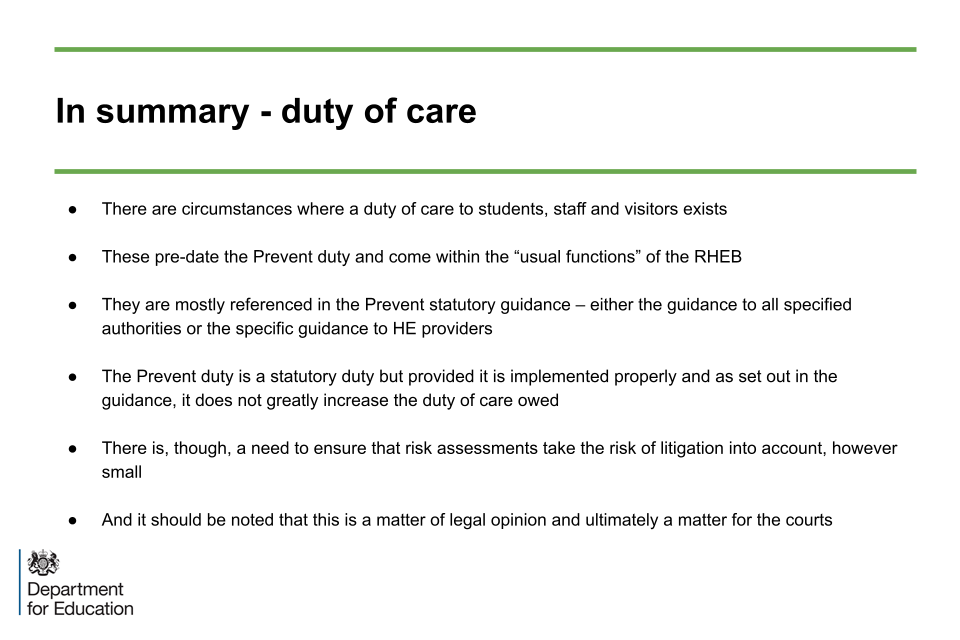
An image of slide 22: In summary - duty of care
